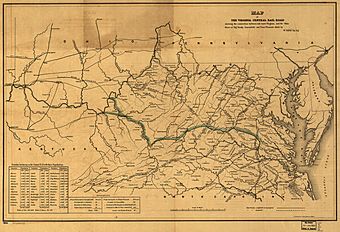Covington and Ohio Railroad facts for kids

1852 map showing the planned Covington and Ohio Railroad and the Virginia Central Railroad
|
|
| Overview | |
|---|---|
| Locale | Virginia, United States |
| Successor | Chesapeake and Ohio Railway |
The Covington and Ohio Railroad was a big plan in the 1850s to build a railroad connecting eastern Virginia to the Ohio River. This was a huge challenge because of the tall Allegheny Mountains and the Appalachian Plateau.
This railroad was never officially created as its own company. Instead, it became part of the Chesapeake and Ohio Railway in 1868. With leaders like Williams Carter Wickham and Collis Potter Huntington, the full railway opened in 1873. Today, parts of these tracks are used by CSX Transportation. They are very important for moving coal from West Virginia to coal piers in Newport News, Virginia.
Contents
Why a Railroad Was Needed
For a long time, people in Virginia wanted an easier way to move goods and travel. They dreamed of a link between rivers that flowed to the Chesapeake Bay and the Atlantic Ocean, and the Ohio River. The Ohio River leads to the Mississippi River and then to the Gulf of Mexico.
Even George Washington helped map out possible routes in the 1700s. He even invested in a canal project. The James River and Kanawha Canal was a big effort to create this water link. But after 1830, new railroad technology showed a better way to connect these areas.
The Virginia Central Railroad
Early railroads in Virginia were owned by private companies. But the state often helped pay for them through the Virginia Board of Public Works. This board wanted to improve transportation in Virginia.
The Virginia Central Railroad started in 1836. It was one of the oldest railroads in the state. The state owned 40% of its shares. By the 1850s, it stretched west from Richmond, Virginia through the Piedmont region. The plan was to extend it across the Blue Ridge Mountains into the Shenandoah Valley and further west. However, building across the Blue Ridge Mountains was very difficult and expensive.
Building the Blue Ridge Railroad
To help with this tough job, the Virginia General Assembly created a new company called the Blue Ridge Railroad. This state-owned company was meant to build across the Blue Ridge Mountains.
Instead of a harder route, they chose Rockfish Gap. A brilliant engineer named Claudius Crozet led the project. They built four tunnels, including the 4,263-foot Blue Ridge Tunnel. This was one of the longest tunnels in the world at the time!
The main tunnel was finished on Christmas Day, 1856. It was almost perfectly straight, even though they dug from both ends. Trains started using the tunnel in April 1858. The Blue Ridge Railroad stopped being a separate company once the tunnels were done. It became part of the Virginia Central Railroad. During the American Civil War, these tunnels were used by Confederate troops, including those of General Stonewall Jackson.
From Covington to the Ohio River
In the 1850s, the biggest challenge was still ahead. This was building through the rough Allegheny Front (eastern side) of the Appalachian Plateau. The goal was to reach the Kanawha River, which flows into the Ohio River.
In 1853, the Virginia government decided to build a railroad from Covington, Virginia to the Ohio River. This project was called the Covington and Ohio Railroad. The state started construction using its own money. They did a lot of work, including grading the land and digging many tunnels through the mountains. They also worked near Charleston, West Virginia on the Kanawha River. But the American Civil War stopped all this work.
After the war, Virginia no longer had money for the project. The war had caused a lot of damage. Also, West Virginia had become a new state in 1863. The two states argued for many years about how to share Virginia's old debts.
However, both Virginia and West Virginia still wanted the railroad finished. They tried to get private companies to build the Covington and Ohio line. But no one wanted to take on the project without state money.
So, in 1868, the existing Covington and Ohio project was combined with the Virginia Central Railroad. This new company was named the Chesapeake and Ohio Railway (C&O).
Creating the Chesapeake and Ohio Railway
The leader of the Virginia Central Railroad was a former Confederate General, Williams Carter Wickham. He looked for money to finish the railroad. He went to New York City and found a powerful businessman named Collis Potter Huntington. Huntington agreed to invest and help find more money.
The last rail spike for the 428-mile line was driven on January 29, 1873. This happened at the Hawk's Nest railroad bridge in the New River Valley. This marked the completion of the line from Richmond to the Ohio River.
Coal to Newport News
Collis Huntington also saw a big opportunity. He knew that West Virginia had huge amounts of coal that could be shipped east. After the railroad was finished, he started buying land in eastern Virginia.
In the 1880s, he oversaw the extension of the C&O's new line, called the Peninsula Subdivision. This line went from Richmond, Virginia through Williamsburg, Virginia to Newport News, Virginia. In Newport News, the company built coal piers on the harbor of Hampton Roads. This allowed coal to be loaded directly onto ships.
Modern Use of the Railroad
Today, parts of the old Covington and Ohio Railroad are still used. They are an important part of the rail network for CSX Transportation.
Images for kids


